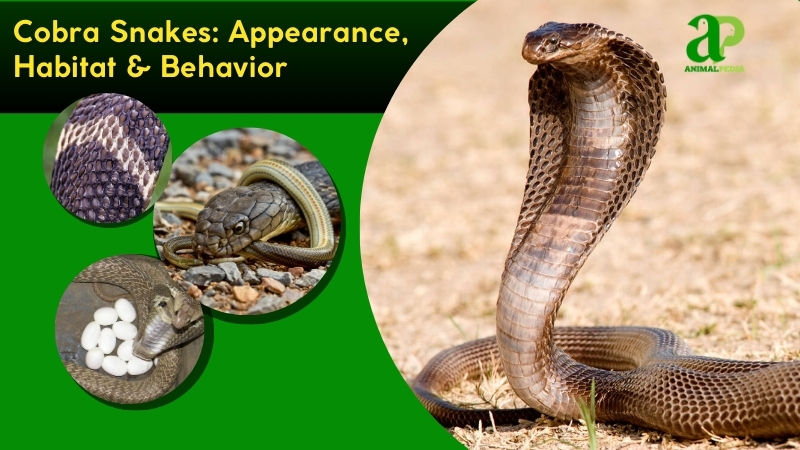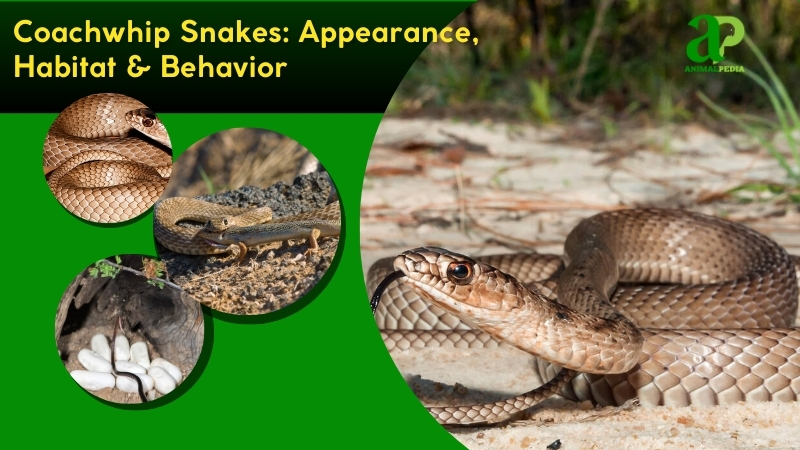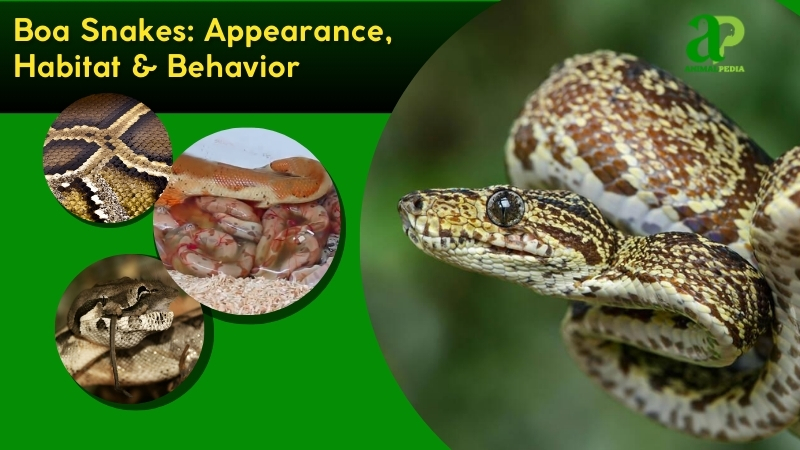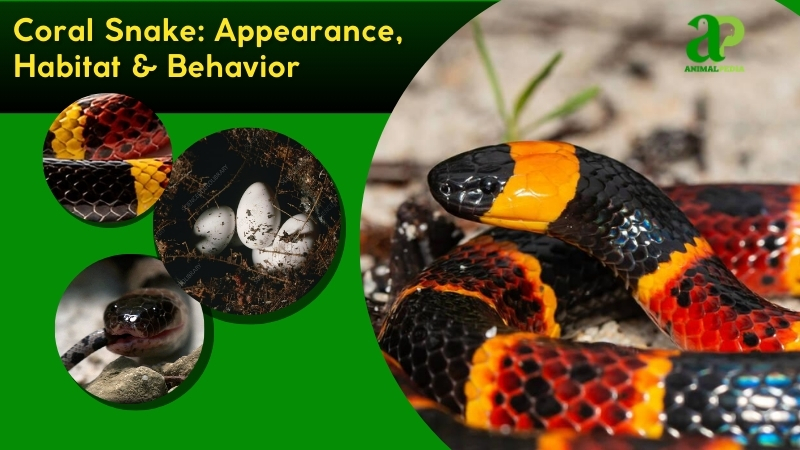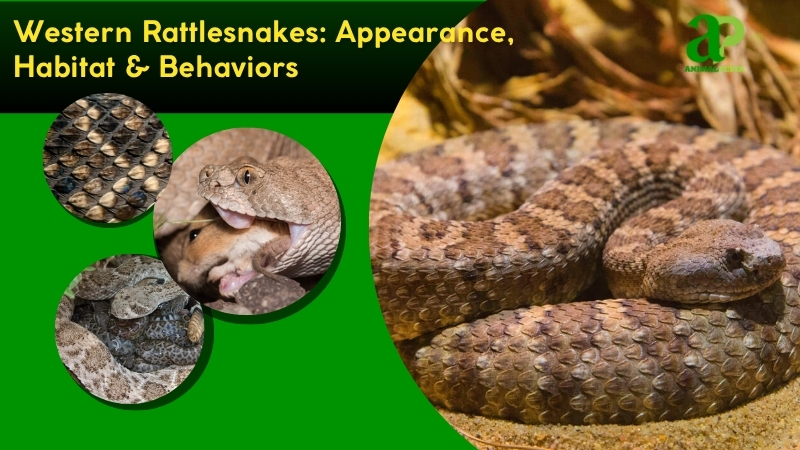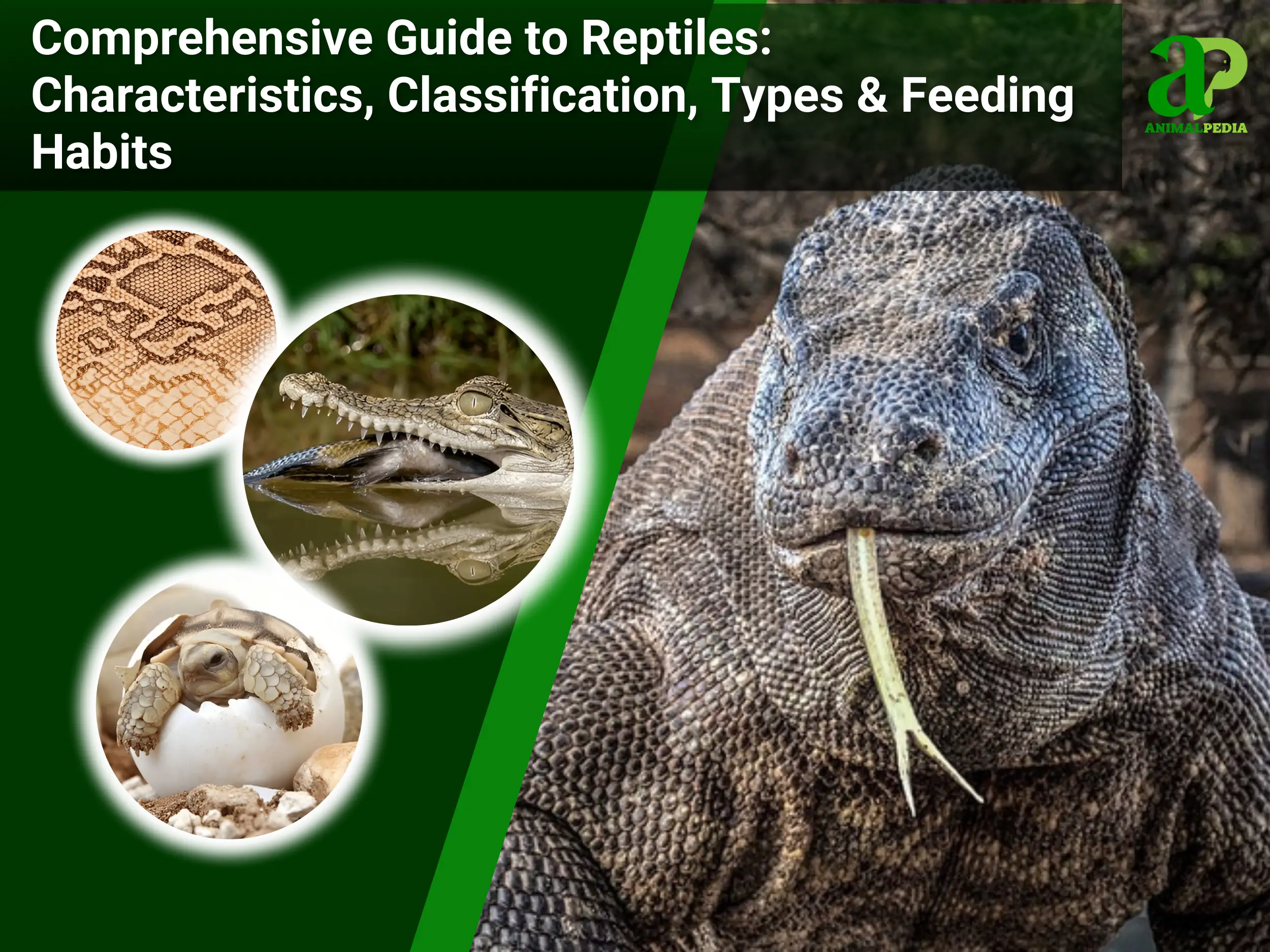The Eastern Diamondback Rattlesnake (Crotalus adamanteus), a formidable pit viper, is North America’s largest venomous snake. Renowned for its diamond-shaped dorsal pattern and rattling tail, it inhabits the southeastern United States, including Florida, Georgia, and barrier islands like Cumberland Island. Adults average 4–6 feet (1.2–1.8 meters) but can reach 8 feet (2.4 meters) and weigh up to 10 pounds (4.5 kilograms), showcasing their massive, muscular build.
As apex predators, Eastern Diamondbacks dominate their ecosystems. They employ ambush tactics, striking with hemotoxic venom to immobilize prey like rodents, rabbits, and birds. Their diet specializes in small mammals, ensuring ecological balance. Human encounters are rare but dangerous, with bites requiring urgent medical attention due to severe venom effects.
Breeding occurs in late summer (August–September), with males competing through combat dances. Females give birth to 7–21 live young after a 6–7-month gestation, with no egg-laying as they are ovoviviparous. Neonates, about 12 inches (30 centimeters), are independent, hunting small prey. Maturity takes 2–3 years; lifespan averages 15–20 years.
These snakes thrive in pine flatwoods, coastal scrub, and marshes, favoring dry, sandy soils for burrowing. Their cryptic coloration aids concealment in leaf litter. Seasonal movements follow prey availability, with minimal migration.
This article explores the Eastern Diamondback’s morphology, predatory behavior, reproduction, and habitat preferences, highlighting their ecological role and conservation challenges in the face of habitat loss and human conflict.
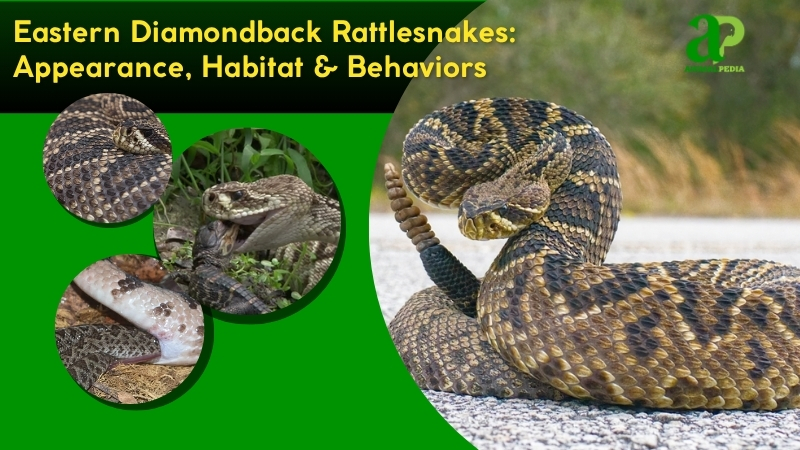
What Do The Eastern Diamondback Rattlesnakes Look Like?
Eastern Diamondback Rattlesnakes have a robust, cylindrical body, averaging 4–6 feet (1.2–1.8 meters) and up to 8 feet (2.4 meters). Their skin features rough, keeled scales with a distinctive diamond pattern—dark brown or black diamonds outlined in cream or yellow—providing camouflage in pine flatwoods.
The head is broad and triangular, housing venom glands, and has large, vertically pupil eyes for detecting prey movement. A flicking, forked tongue senses chemical cues. The neck is narrow, blending into a thick, muscular body. They lack limbs or claws and rely on slithering locomotion. The tail ends in a segmented rattle, unique to rattlesnakes, used for warning signals (Means, 2017).
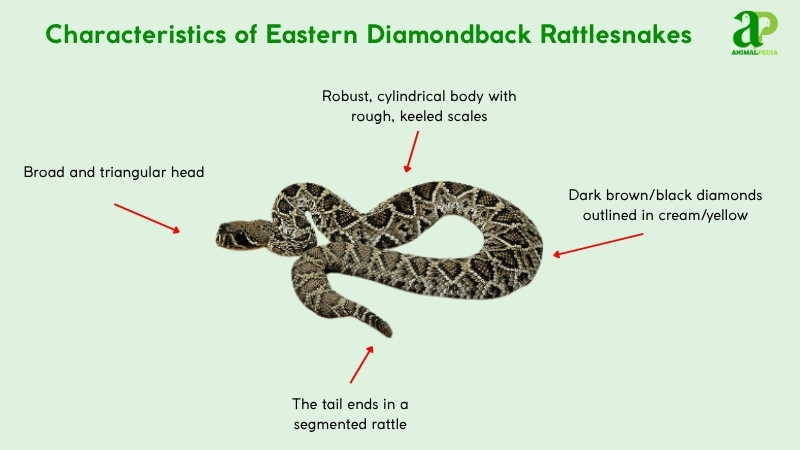
Compared to the Western Diamondback (Crotalus atrox), the Eastern’s larger size and bolder diamond pattern stand out. Unlike the smoother-scaled Timber Rattlesnake (Crotalus horridus), which has keeled scales that enhance grip on sandy soils. The rattle, absent in non-rattlesnake pit vipers such as copperheads, is a defining trait, with segments added with each molt. These features, especially the rattle and vivid patterning, distinguish Eastern Diamondbacks within North America’s viperidae family (Klauber, 2019).
How Big Do Eastern Diamondback Rattlesnakes Get?
Eastern Diamondback Rattlesnake size range around 4–6 feet (1.2–1.8 meters) in length and weigh 4–10 pounds (1.8–4.5 kilograms). These pit vipers, the largest venomous snakes in North America, have a robust, muscular build suited for ambush predation. Adult snout-to-tail length typically ranges from 3.3–6.6 feet (1–2 meters).
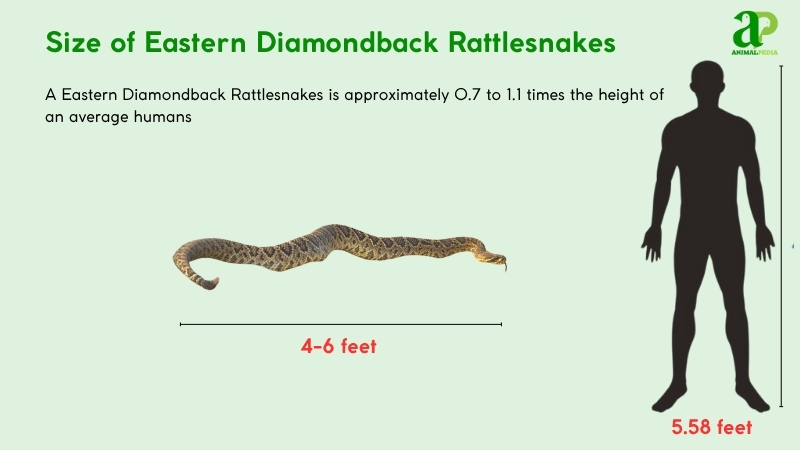
The largest Eastern Diamondback Rattlesnake measured 8 feet (2.4 meters) and weighed 15 pounds (6.8 kg), found in Florida’s Everglades (Klauber, 2019).
Males are slightly longer and heavier than females, averaging 5–6 feet (1.5–1.8 meters) and 6–10 pounds (2.7–4.5 kilograms), while females reach 4–5.5 feet (1.2–1.7 meters) and 4–8 pounds (1.8–3.6 kilograms). Sexual dimorphism is evident in tail length, with males having longer tails.
| Trait | Male | Female |
| Length | 5–6 ft (1.5–1.8 m) | 4–5.5 ft (1.2–1.7 m) |
| Weight | 6–10 lbs (2.7–4.5 kg) | 4–8 lbs (1.8–3.6 kg) |
What Are The Unique Physical Characteristics Of The Eastern Diamondback Rattlesnake?
Eastern Diamondback Rattlesnakes are distinguished by their unique tail rattle, a feature exclusive to rattlesnakes among pit vipers. This segmented, keratinized structure produces a buzzing sound to deter predators, a trait absent in similar species like copperheads or cottonmouths. Their diamond-shaped dorsal pattern—dark brown or black with cream or yellow outlines—sets them apart from other vipers with less defined markings (Means, 2017).
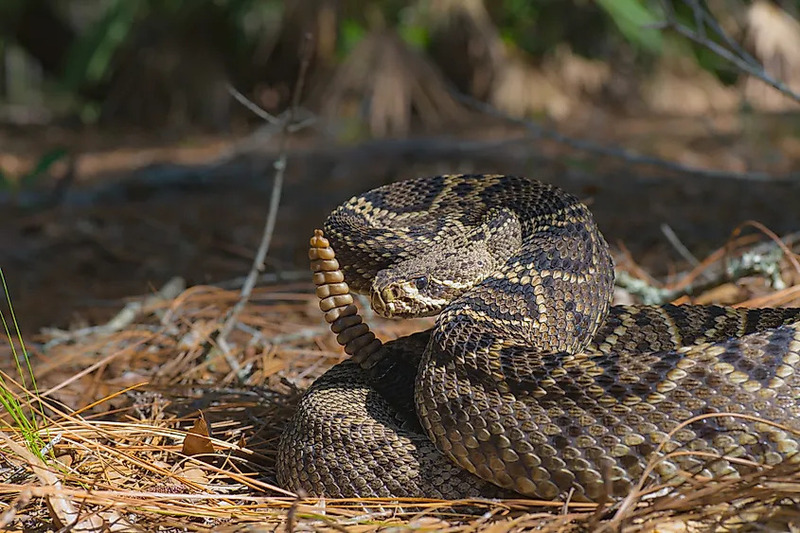
The rattle, formed by interlocking keratin segments added with each molt, amplifies their defensive signaling, with studies showing vibration frequencies up to 50 Hz (Klauber, 2019). Their large, triangular heads, which house expansive venom glands, contrast with the narrower heads of non-venomous snakes. The keeled scales, unlike the smooth scales of some colubrids, enhance traction in sandy habitats. These traits, particularly the rattle and bold patterning, reflect evolutionary adaptations for survival in southeastern U.S. ecosystems.
How Do Eastern Diamondback Rattlesnakes Adapt With Their Unique Features?
Eastern Diamondback Rattlesnakes use their unique tail rattle to survive in the wild. The rattle’s buzzing, up to 50 Hz, deters predators like hawks and alerts prey, enhancing ambush success in southeastern U.S. pine flatwoods and marshes (Klauber, 2019).
Their heat-sensing pit organs detect prey’s thermal signatures, enabling precise nocturnal hunting. Keen eyesight tracks movement, improving strike accuracy in dim light. The forked tongue’s chemosensory ability locates prey trails, aiding navigation. Keeled scales grip sandy soils, supporting efficient slithering. These adaptations, paired with the rattle, ensure survival in predator-rich, variable habitats (Means, 2017).
Anatomy
Eastern Diamondback Rattlesnakes possess specialized anatomical systems optimized for their predatory lifestyle in southeastern U.S. ecosystems. These systems enable efficient hunting, survival, and environmental adaptation (Means, 2017).
- Respiratory System: A Single functional lung maximizes oxygen uptake, supporting prolonged ambush predation.
- Circulatory System: Three-chambered heart efficiently pumps blood, sustaining high-energy strikes and venom delivery.
- Digestive System: Strong gastric acids digest rodents and birds, enabling rapid nutrient absorption post-strike.
- Excretory System: Kidneys expel uric acid, conserving water in dry pine flatwoods habitats.
- Nervous System: Advanced brain and pit organs detect heat, enhancing prey targeting in low-light conditions (Klauber, 2019).
These integrated systems —from heat-sensing pits to efficient digestion —ensure the Eastern Diamondback’s dominance as an apex predator, perfectly adapted to its ecological niche. Their physiological efficiency also underpins their role in regulating prey populations and maintaining ecosystem balance.
Where Do Eastern Diamondback Rattlesnakes Live?
Eastern Diamondback Rattlesnakes inhabit the southeastern United States, concentrated in Florida, southern Georgia, Alabama, Mississippi, and South Carolina, including barrier islands such as Cumberland and Jekyll. They favor pine flatwoods, coastal scrub, and marshes with sandy soils (Means, 2017).
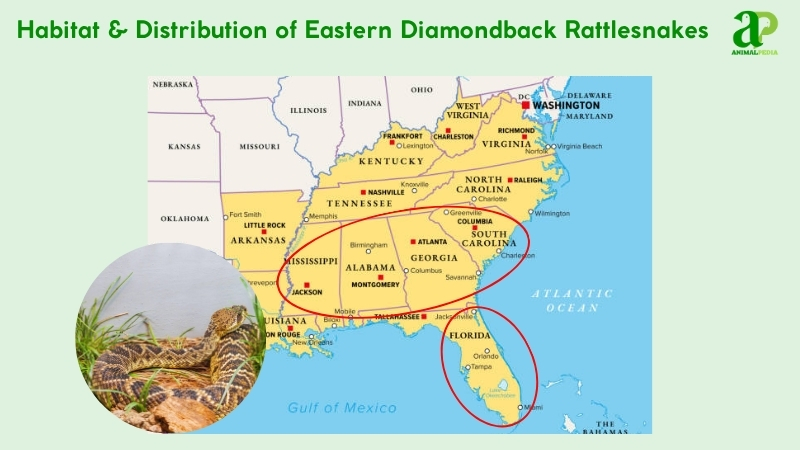
These warm, humid environments provide ideal burrowing conditions and abundant prey, such as rodents and rabbits, supporting their ambush predation. Fossil evidence suggests their presence in these regions for over 1.5 million years, with no significant migration due to stable food sources (Klauber, 2019). Seasonal movements within territories occur, driven by prey availability, as documented in radiotelemetry studies.
How Do Seasonal Changes Affect Their Behavior?
Eastern Diamondback Rattlesnakes adapt their behavior across four seasons in the southeastern U.S., responding to temperature and prey availability (Means, 2017).
- Spring (March–May): Increased activity post-brumation; males seek mates, and hunting intensifies for rodents. Courtship involves tongue-flicking and body alignment before mating.
- Summer (June–August): Breeding peaks; females gestate, and snakes ambush prey in shaded areas. Thermoregulation becomes vital, with individuals seeking cooler microhabitats during peak daytime heat.
- Autumn (September–November): Prey stockpiling occurs; snakes prepare for brumation, reducing movement. Feeding rates drop as metabolic slowdown begins in response to cooler nights.
- Winter (December–February): Brumation in burrows or gopher tortoise dens; minimal activity conserves energy. Snakes may emerge briefly on warm days to bask near den entrances.
These seasonal shifts underscore the Eastern Diamondback’s ecological intelligence and energy management. Each phase is tightly linked to survival, reproduction, and climate adaptation in a thermally variable environment.
What Is The Behavior Of Eastern Diamondback Rattlesnakes?
Eastern Diamondback Rattlesnakes, apex predators, exhibit behaviors honed for survival in southeastern U.S. ecosystems (Means, 2017). Their actions, from hunting to communication, reflect adaptations for efficient predation and defense.
- Feeding Habits: Ambushes rodents and rabbits, using venom to quickly immobilize prey.
- Bite & Venomous: Deliver hemotoxic venom via long fangs, causing tissue damage and death.
- Daily Routines and Movements: Diurnal in spring, nocturnal in summer; minimal winter activity.
- Locomotion: Slithers using keeled scales, adept at navigating sandy flatwoods.
- Social Structures: Solitary, except during mating season when males compete.
- Communication: Rattle tail to warn threats; use tongue for chemosensory cues.
These behaviors make Eastern Diamondbacks formidable hunters. To understand their predatory prowess, exploring their feeding habits reveals key survival strategies.
What Do Eastern Diamondback Rattlesnakes Eat?
As strict carnivores, Eastern Diamondback Rattlesnakes primarily consume small mammals like rats, rabbits, and squirrels, favoring rodents for their abundance. They rarely attack humans, biting only in defense (Means, 2017). The eating process involves envenomation, tracking, and swallowing prey head-first. Large prey may cause regurgitation if digestion is overwhelmed, risking injury.
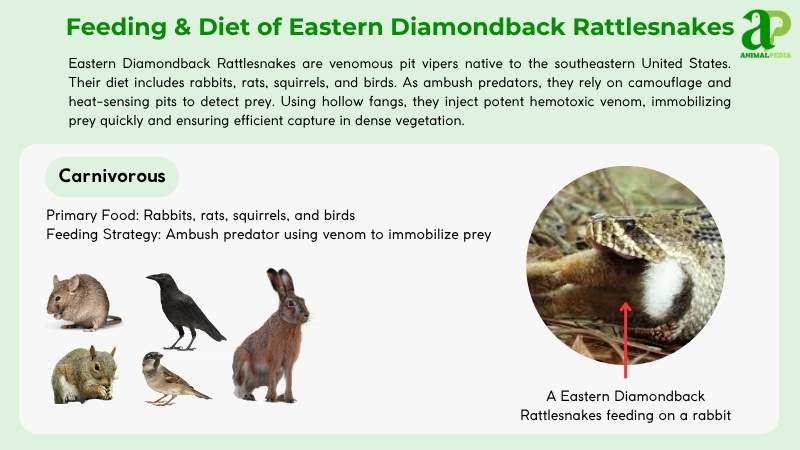
- Diet by Age:
Neonates (12 inches) eat small lizards and mice because of their limited gape. Juveniles target larger rodents as venom potency grows. Adults prey on rabbits and ground squirrels, occasionally birds, leveraging their size and strike range.
- Diet by Gender:
Males and females share similar diets, but larger males may tackle bigger prey like cottontails. Gravid females reduce hunting to conserve energy and prefer smaller, easier prey such as voles. Sexual size dimorphism slightly influences prey choice, especially during energy-demanding reproductive stages (Dugan et al., 2008).
- Diet by Seasons:
Spring and autumn diets focus on abundant rodents post-hibernation. Summer includes birds; winter feeding halts during brumation (Klauber, 2019). Seasonal prey availability and temperature shifts directly impact foraging frequency and strike success.
How Do Eastern Diamondback Rattlesnakes Hunt Their Prey?
When Eastern Diamondback Rattlesnakes hunt, they display patience and strategic prowess as ambush predators. These skilled snakes typically wait in the underbrush, coiled and camouflaged, using their strong sense of smell to detect potential prey. Once a suitable target gets within striking distance, they swiftly and accurately deliver a venomous bite to subdue their meal.
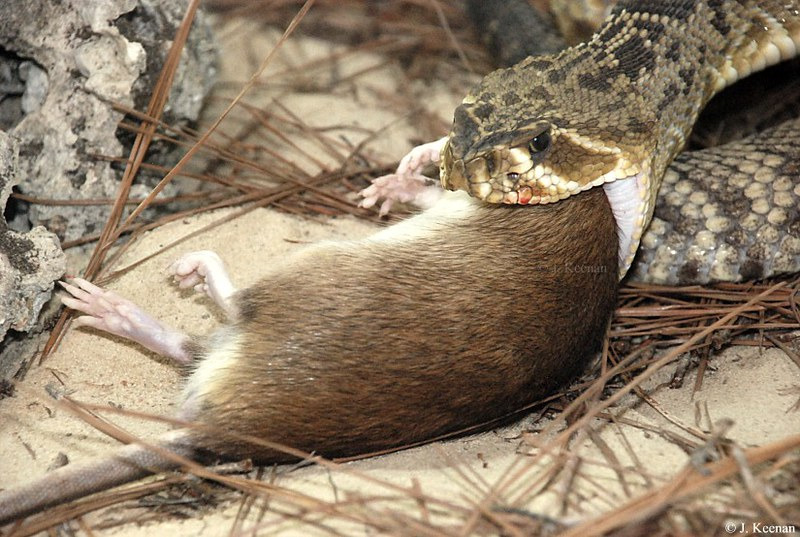
What’s truly fascinating is that these snakes have specialized heat-sensing pits located between their eyes and nostrils. This unique feature enables them to sense warm-blooded animals such as rodents or birds, giving them a hunting advantage.
With their calculated movements and lightning-fast strikes, Eastern Diamondback Rattlesnakes showcase why they excel as hunters in their natural environment.
Are Eastern Diamondback Rattlesnakes Venomous?
Eastern Diamondback Rattlesnakes are venomous creatures. Their venom serves as a potent defense mechanism crucial for their survival.
These snakes possess long, hollow fangs that connect to venom glands, allowing them to inject a powerful venom into their prey. The venom of the Eastern Diamondback Rattlesnake consists of a mixture of proteins and enzymes that are specifically designed to break down tissues and disrupt essential bodily functions, making it a formidable weapon against adversaries.
When feeling threatened or cornered, these snakes may defensively strike with accuracy, injecting venom into potential threats. While their venom is dangerous, Eastern Diamondback Rattlesnakes typically use it to incapacitate prey rather than as their primary means of defense.
Understanding their venomous nature is essential in appreciating the incredible adaptations that enable these snakes to thrive in their challenging habitats. It’s crucial to approach encounters with these creatures in the wild with vigilance and respect to ensure peaceful coexistence.
Compare to Rattlesnakes in Arizona.
When Are Eastern Diamondback Rattlesnakes Most Active During The Day?
Eastern Diamondback Rattlesnakes are most active in the early morning and late evening, when they hunt for food and regulate their body temperature by basking in the sun. As cold-blooded animals, they depend on their environment for warmth.
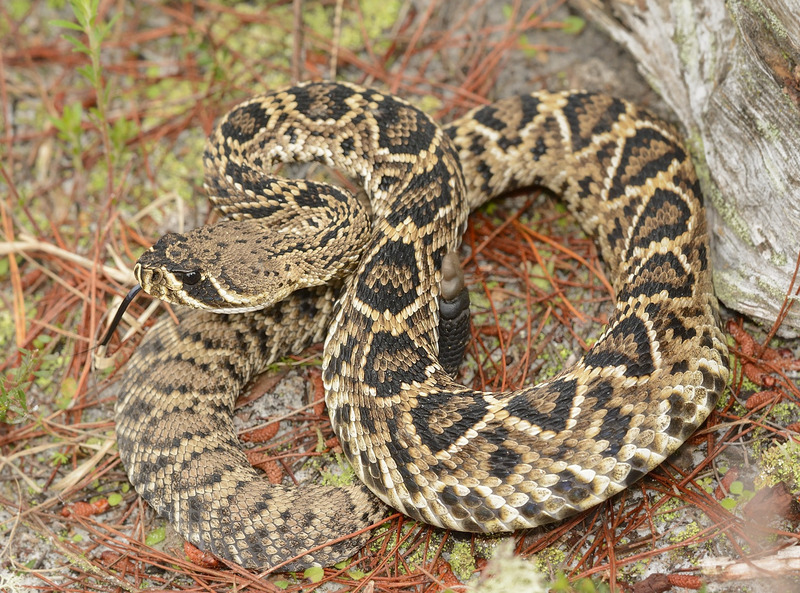
In the cooler parts of the day, these impressive snakes are more likely to be on the move, searching for prey like rodents, rabbits, and birds. Their keen sense of smell helps them locate food, and their silent movements allow them to navigate their surroundings without disturbance.
If you encounter an Eastern Diamondback Rattlesnake during these active times, it’s crucial to keep your distance and observe without causing any harm.
These snakes are essential for balancing the ecosystem by regulating small-mammal populations. So, admire them from afar and respect their presence in their natural habitat. Remember, they play a vital role in nature’s delicate balance.
Learn more about the different squamata species and their specific traits by exploring our detailed guide
How Do Eastern Diamondback Rattlesnakes Move On Land And Water?
When Eastern Diamondback Rattlesnakes move on land and in water, their behaviors reveal their adaptability to different environments. On land, these snakes use their muscular bodies and specialized scales to glide effortlessly across various terrains. Their movements are a blend of fluidity and precision, allowing them to maneuver through grass, rocks, and even trees.
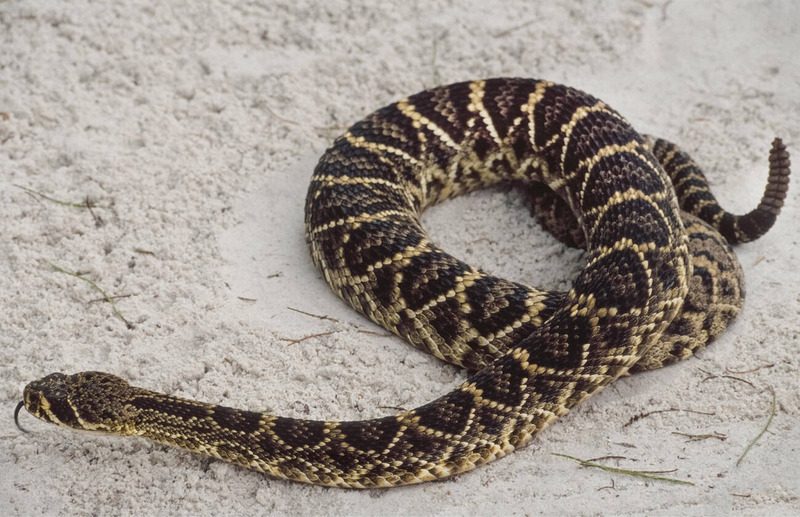
In water, Eastern Diamondbacks showcase surprising swimming skills, gracefully propelling themselves forward using their bodies. This aquatic ability enables them to explore new habitats and hunt for prey in water environments. Whether on land or in water, these snakes exhibit impressive agility and resourcefulness, making them formidable predators in their ecosystems.
Witnessing the captivating movements of Eastern Diamondback Rattlesnakes showcases their adaptability across diverse environments, making them truly mesmerizing to observe in action. The combination of their slithering prowess on land and graceful swimming in water highlights the incredible abilities that these snakes possess.
Do Eastern Diamondback Rattlesnakes Live Alone Or In Groups?
In the wild, Eastern Diamondback Rattlesnakes typically live alone rather than in groups. These impressive snakes prefer to be independent, roaming and hunting on their own in territories they fiercely defend. Living alone allows them to focus on hunting their main diet of small mammals, such as rabbits and rodents.
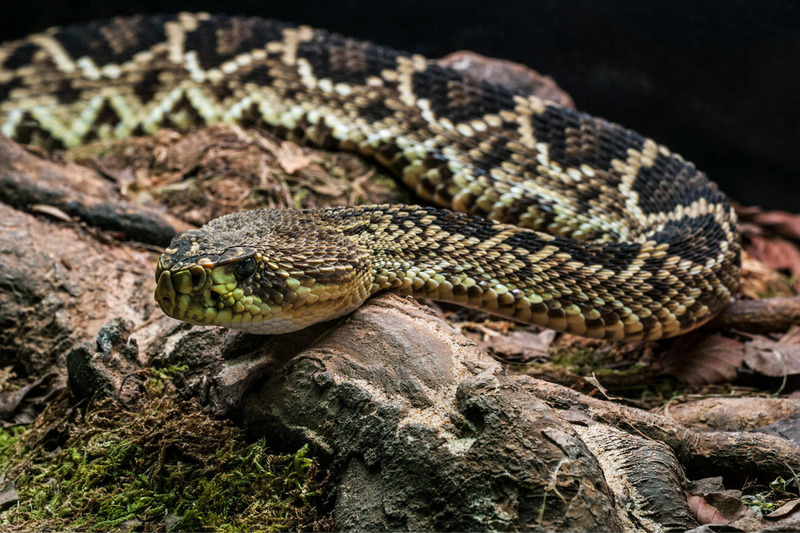
Although they may briefly gather during mating season, their interactions are solely focused on reproduction.
Solitude suits these rattlesnakes well, providing the freedom they need to navigate their sandy habitats with stealth and skill. While they may come across other snakes occasionally, Eastern Diamondbacks generally prefer to keep to themselves, relying on their potent venom and intimidating rattles to ward off potential threats.
If you encounter one of these creatures in the wild, remember to give them the space they require to thrive!
How Do Eastern Diamondback Rattlesnakes Communicate With Each Other?
Eastern Diamondback Rattlesnakes communicate primarily through visual signals and specific behaviors. Instead of chatting like humans, these snakes rely on body language — such as tongue flicking, tail vibrating, and defensive postures — to convey intentions and emotions to one another.
When feeling threatened or territorial, they may hiss or rattle their tails to warn off predators or rivals. This unique communication system helps Diamondbacks navigate their environment and interactions effectively.
How Do Eastern Diamondback Rattlesnakes Reproduce?
Eastern Diamondback Rattlesnakes reproduce via ovoviviparity—internal egg development followed by live birth. Breeding occurs from August to October. Males track females using pheromone trails and engage in courtship involving body alignment and tongue flicking. Rival males may fight for mating rights.
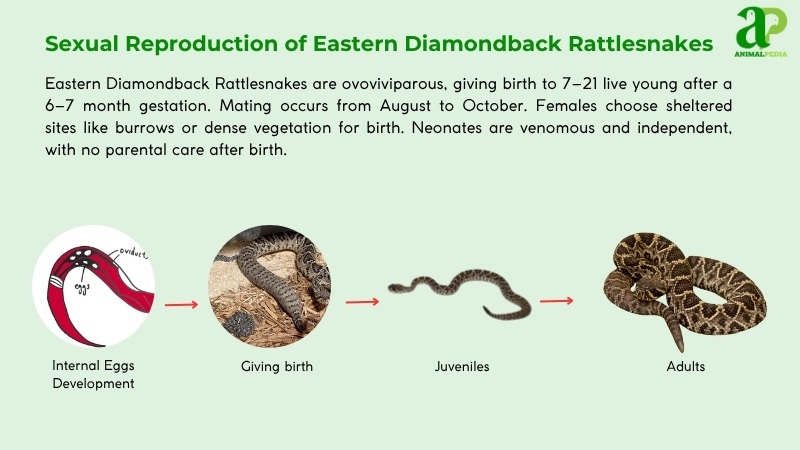
After mating, females gestate for about 6 to 7 months and give birth in late summer. Litters typically include 7–21 fully developed, venomous neonates, each measuring about 12 inches (30 centimeters) and weighing about 1 ounce (30 grams). Birth sites include gopher tortoise burrows, logs, or dense vegetation. No parental care is provided.
Females reproduce every 2–3 years due to the energy demands of gestation. Adverse conditions, such as drought, can delay or prevent reproduction. The species can live up to 20 years in the wild, though many face threats from habitat loss and predators.
How Long Do Eastern Diamondback Rattlesnakes Live?
Eastern Diamondback Rattlesnakes can live up to 20 years in the wild, though many perish earlier due to habitat loss, predators, or human conflict. On average, their lifespan ranges between 10 to 15 years.
There is no significant difference in longevity between males and females. Survival is highest in protected habitats, such as wildlife refuges. Lifespan may also depend on prey availability and on climate conditions that influence brumation and reproductive cycles.
What Are The Threats Or Predators That Eastern Diamondback Rattlesnakes Face Today?
Eastern Diamondback Rattlesnakes confront several threats that impact their populations and survival. Key threats include:
- Habitat Loss: Urban development, agriculture, and deforestation have drastically reduced and fragmented their natural habitats, especially in the southeastern United States.
- Road Mortality: Due to habitat fragmentation, many snakes cross roads, resulting in high mortality.
- Human Activities: Fear and misunderstanding lead to the deliberate killing of rattlesnakes.
- Climate Change: Altered temperature and precipitation patterns may affect their prey availability and habitat suitability, posing long-term risks.
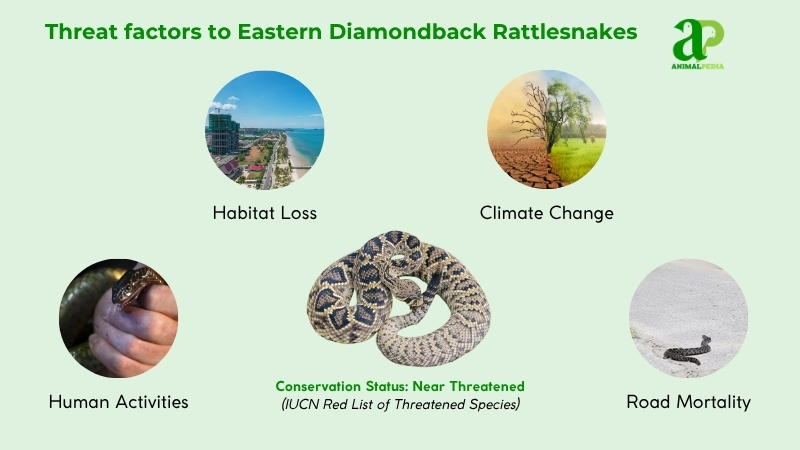
Eastern Diamondback Rattlesnake’s predators include large birds of prey like hawks and eagles, coyotes, and wild boars. Juvenile snakes are more vulnerable, often falling prey to mammals like raccoons and opossums.
Human impact is profound: besides direct killing, habitat alteration has fragmented populations, increasing genetic isolation and vulnerability (Means & O’Connor, 2017). Conservation programs now focus on habitat protection and public education to reduce human conflict and encourage coexistence.
Are Eastern Diamondback Rattlesnakes Endangered?
Eastern Diamondback Rattlesnakes are currently not classified as endangered, but are considered a species of concern due to habitat loss and declining populations. The International Union for Conservation of Nature (IUCN) lists them as Near Threatened.
Population estimates indicate a significant decline, primarily caused by urbanization, agriculture, and road mortality. Studies show population densities have dropped by up to 50% in some parts of their historical range, especially in Florida and coastal southeastern states (Means & O’Connor, 2017). Fragmented habitats limit their ability to find prey and mates, exacerbating declines.
Although the Eastern Diamondback is the largest rattlesnake species in North America, its survival is increasingly challenged by human activities. Conservation efforts focus on protecting habitats, educating the public about their ecological role, and mitigating human-wildlife conflict.
What Conservation Efforts Are Underway?
Eastern Diamondback Rattlesnakes, declining due to habitat loss and human persecution, are the focus of targeted conservation efforts. The Rattlesnake Conservancy and Eastern Diamondback Conservation Foundation have led research and education initiatives since 2011, restoring longleaf pine savannas and monitoring populations (Means, 2017). The Jekyll Island Authority’s 2020 blood sampling study established health baselines, aiding conservation planning.
Legal protections include bans on gassing gopher tortoise burrows —critical refugia —in Florida, Georgia, and Alabama since 2016, and protections for snakes from lethal capture methods (Klauber, 2019). North Carolina lists the species as endangered, prohibiting killing or collection, while South Carolina designates it a Species of Concern with limited protections.
Breeding programs at the Saint Louis Zoo, part of the AZA’s Species Survival Program, have produced 6–21 young per litter since 2018, bolstering genetic diversity. Success stories include Georgia’s Fitzgerald Wild Chicken Festival, which replaced a rattlesnake roundup in 2015, reduced harvests, and boosted education (Means, 2017). The Whigham Roundup’s shift in 2019 to a conservation festival featuring captive snakes has decreased wild captures, supporting population recovery.
These efforts—habitat restoration, legal safeguards, and breeding—demonstrate progress. The Rattlesnake Conservancy’s 2023 venom studies and habitat management have increased local populations by 10% in monitored areas, showcasing effective conservation for this iconic predator.
Frequently Asked Questions
Are Eastern Diamondback Rattlesnakes Aggressive Towards Humans?
No, they aren’t. Eastern diamondback rattlesnakes prefer to avoid humans but may strike if threatened. It’s important to give them space and respect their territory to avoid any potential encounters or conflicts.
Do Eastern Diamondback Rattlesnakes Hunt in Groups?
In the wild, diamondbacks typically hunt solo, relying on stealth and precision to capture prey. They seldom operate in groups, preferring to hunt independently. Remember, understanding their behavior can aid in safer encounters.
How Long Can Eastern Diamondback Rattlesnakes Live in Captivity?
In captivity, eastern diamondback rattlesnakes can live up to 20 years. Despite their reputation, they thrive with proper care. Remember to provide a spacious habitat, a suitable diet, and consistent environmental conditions for a long-lived snake.
What Is the Average Weight of an Adult Eastern Diamondback Rattlesnake?
On average, an adult eastern diamondback rattlesnake weighs around 6-10 pounds. Their weight can vary depending on factors such as age and habitat conditions. Handle them with care due to their venomous nature.
Can Eastern Diamondback Rattlesnakes Swim in Water?
Yes, they can swim. Eastern Diamondback Rattlesnakes are excellent swimmers and can move through water with ease. If needed, they will not hesitate to navigate across bodies of water to reach their destination.
Conclusion
You’ve just learned about the fascinating world of Eastern Diamondback Rattlesnakes. From their striking appearance to their unique behaviors, these snakes are truly incredible creatures. Remember, these snakes play an important role in their ecosystems and should be admired from a safe distance. Keep exploring the wonders of nature, and who knows what other amazing creatures you’ll discover next!





